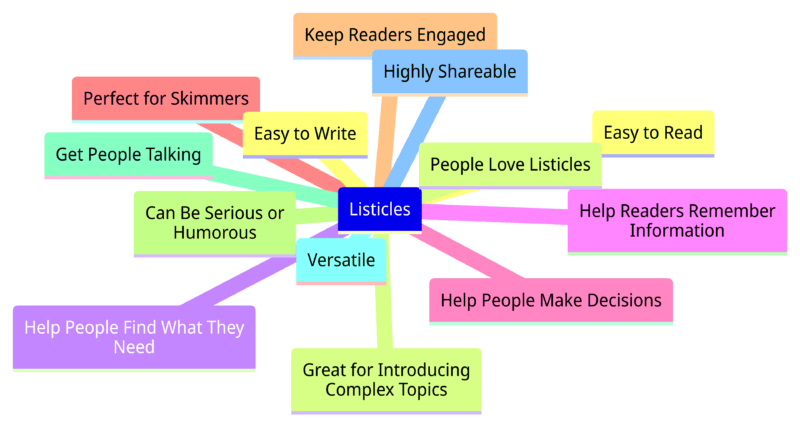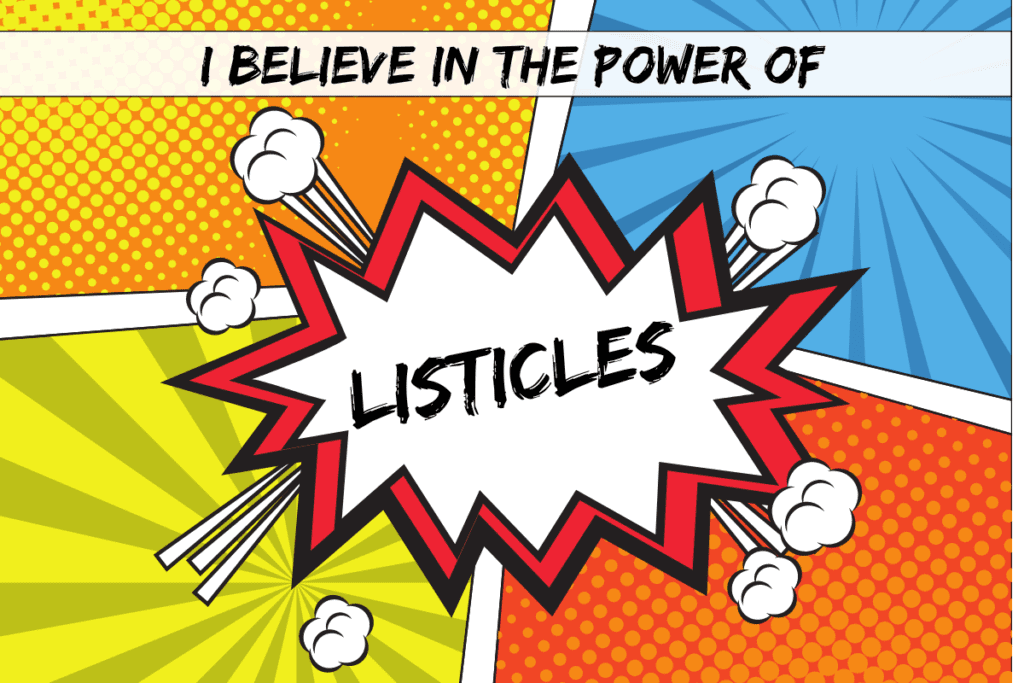The internet is a funny place.
If I had lived under a rock for most of my life, I would probably think it was a funeral parlor because something seems to be dying every week.
From print media to the family unit, everything is on its deathbed.
The latest victim?
The listicle. Everywhere you turn, someone is asking, “Are listicles dead?”
Listicles are not dead and will never die because they are easy to read and provide information in an easily digestible format. Even though they are not as in-depth as other types of content, they are still valuable because they can introduce complex topics or provide an overview of a particular subject.

| Key Takeaway | Explanation |
|---|---|
| Listicles are easy to read | Listicles provide information quickly and are convenient for time-strapped readers. |
| Listicles simplify complex topics | They can break down intricate subjects into digestible pieces. |
| Listicles help find information | They provide specific lists around topics, enabling faster internet searches. |
| Listicles aid memory | The list format enhances information retention. |
| Listicles assist decision-making | They provide a comparative framework for options. |
| Listicles are skimmer-friendly | They allow quick scanning and finding of needed information. |
| Listicles keep readers engaged | Their structure prevents readers from losing interest. |
| Listicles are versatile | They can deliver serious or light-hearted content. |
| Listicles stimulate conversation | They can spark debate and build community around a topic. |
| Listicles are universal | They can cover a wide range of topics in any field. |
| Listicles are shareable | Their format makes them easily distributable on social media. |
| Listicles are easy to write | They provide a clear writing framework, but still require skill to create. |
| People love listicles | The list format appeals to our need for structure. |
| Listicles have longevity | Their presence since ancient times suggests future popularity. |
If they’re so great, why do listicles have so many critics? It seems like every other article about listicles bemoans their existence and claims they should die a fiery death.
Preferably while being shot out of a cannon.
So, why do listicles get so much hate? Let’s take a look.
Table of Contents
Listicles and Their Critics
Listicles are often criticized for being shallow, lightweight, and pandering to the lowest common denominator.
And while some listicles are nothing more than fluff, there are plenty of examples of well-researched and informative listicles out there.
The problem is that people tend to lump all listicles together, regardless of quality. It’s like saying that because some novels are poorly written, all novels are trash. Or that because some movies are bad, all movies are garbage.
The thing is, there’s a place for both lightweight and in-depth content, both on the internet and off.
And just because a particular format is easy to consume doesn’t mean it has no value.
Otherwise, the global comic book market wouldn’t have brought in $8.49 billion in 2020, nor would it be expected to grow to $12.8 billion by 2028.
What do comic books have to do with listicles?
Just like listicles, comic books are often criticized for not providing the most elevated and thought-provoking content. And yet, they continue to be popular and generate billions of dollars in revenue every year.
Could that mean that a ridiculous number of people might actually love comics precisely because they are easy to read and don’t require a lot of brain power?
And could that mean that people might actually adore listicles for the very same reasons?
Why yes, it very well could. Oh, my stars, the horror! Go ahead and clutch your pearls. I’ll wait.

Comics and listicles provide easy-to-consume content and that’s why people love both
Now that we’ve gotten that out of the way, let’s look at why listicles will never kick the bucket.
No matter how much some people might want to bury them in the deepest, darkest pits of the internet.
Listicles Are Here to Stay
To some, listicles are like the weird uncle you know will embarrass you at family gatherings but can’t seem to get rid of.
To others, they are the fun aunt who’s always got a wild tale to tell and brings fantastic presents.
Whether you love them or hate them, there’s no denying that listicles are here to stay. Here are 13 reasons why:
1. Listicles Are Easy to Read
In our fast-paced, constantly-connected world, people often don’t have the time or attention span to read long-form content.
Listicles provide a quick and easy way to consume information without committing to reading an entire article.
After all, who has the time (or inclination) to read a 20,000-word article when you can get the same information in a listicle that’s only 1,000 words? No one, that’s who.
2. Listicles Are Great for Introducing Complex Topics
Listicles can be used to introduce complex topics in a way that is easy to understand.
By breaking down a subject into smaller, more manageable pieces, listicles make it possible for people to learn about things they might otherwise be intimidated by.
For example, someone might be interested in learning how to code but feel overwhelmed by the prospect. They have no idea where to start or what they need to know.
At this point, a massive tome detailing everything they need to know to become a master coder would just have them fleeing in terror.
But a listicle titled “15 Coding Terms You Need to Know” is much more approachable. It’s a quick and easy way for someone to dip their toe in without feeling overwhelmed.
3. Listicles Help People Find What They Need
The internet is massive, and finding what you’re looking for can be challenging. That’s where listicles come in.
By their very nature, listicles are designed to be helpful. They provide a specific list of things, whether tips, resources, or information, around a particular theme or topic.
As a result, people can more quickly find what they need without having to turn into archaeologists digging through mounds of dirt to get to the artifact.
4. Listicles Help Readers Remember Information
Listicles are also great for helping readers remember information. Studies show that people are more likely to retain information presented in a list format.
This is likely because our brains are wired to remember things presented in a logical, easy-to-understand way.
When information is presented in a list, it’s easier for our brains to store and recall it later.
5. Listicles Help People Make Decisions
Listicles can also be helpful in decision-making.
When presented with a list of options, people are more likely to make a decision than when presented with a single option.
Lists provide a framework our brains can use to compare and contrast different options.
This makes it easier to reach a decision, even if that decision is just “which of these options do I want to learn more about?”
6. Listicles Are Perfect for Skimmers
We’ve all been there: you’re trying to read an article, but you just can’t focus. Your mind keeps wandering, and before you know it, you’ve lost interest entirely.
When this happens, the only thing you can do is skim the article for the information you need and hope that you didn’t miss anything important.
Listicles are perfect for skimmers because they are easy to scan, and the information is presented in a way that is easy to digest.
As a result, you can quickly find the information you need without having to wade through a bunch of unnecessary text.
7. Listicles Keep Readers Engaged
Using headlines and subheadings in a listicle helps keep readers engaged.
Listicles make it easy for readers to scan an article and quickly find the information they are looking for because they break up the text, making it easily scannable.
It also helps to keep readers from getting bogged down in a long, dense article.
By keeping things concise and easy to understand, listicles keep readers engaged and prevent them from getting bored and wandering off.
If you want to learn how to write a listicle that will keep people reading, check out this article on crafting the perfect listicle structure and this one on finding and vetting listicle ideas.

Listicles keep people engaged because they provide information in an easily scannable format
8. Listicles Can Be Serious or Humorous
Listicles don’t have to be all fun and games. While they are often used to deliver information in a light-hearted way, listicles can also be used to deliver serious information.
For example, a listicle about the dangers of texting and driving could help raise awareness about the issue and potentially save lives.
However, they can also be used to add a little spice and fun to a topic that would otherwise be as fascinating as watching ice melt. In the hands of a skilled writer, a listicle can be both informative and entertaining.
9. Listicles Get People Talking
Listicles are a great way to start a conversation. By sparking debate and encouraging people to share their thoughts, listicles can help to create a sense of community around a particular topic.
They can also help to shed light on different perspectives and allow people to see a topic in a new light. By getting people talking, listicles can help to promote understanding and open-mindedness.
10. Listicles Are Versatile
Listicles are incredibly versatile and can be used to deliver a wide range of information in any field, from history to science to pop culture.
From the functions of the human brain to the best ways to make a perfect cup of coffee, there is no topic that can’t be covered in a listicle.
This versatility is one of the things that makes listicles so popular. No matter your interests, there’s a good chance you can find a listicle relevant to you, no matter how obscure or complicated the topic.
11. Listicles Are Highly Shareable
In the age of social media, listicles are more popular than ever. Thanks to platforms like Twitter and Facebook, listicles can be easily shared, reaching a broad audience in seconds.
This sharing potential is one of the main reasons listicles are so popular with publishers. A well-written listicle has the potential to go viral, reaching millions of people and generating a lot of traffic for the site it is published on.
12. Listicles Are Easy to Write
The fact that listicles seem easy to write is probably one of the more controversial entries in this list.
After all, that’s precisely why the nay-sayers look at them as if they’re the dung they just stepped in and have to scrape off the bottom of their shoe.
And then wash and disinfect it with bleach. And then wash it again.
However, while listicles are easy to write in the sense that they provide a clear framework for the writer to follow, they still require a certain amount of skill and effort to produce a good one.
A listicle is only as good as the writer’s ability to come up with an interesting angle and to write engaging, informative, and well-written content.
It also takes skill to distill complex information into a concise and easy-to-understand format.
13. People Love Listicles
And finally: people love listicles! Lists are like catnip for the human brain.
By organizing information into a list format, listicles tap into our love of lists and our need for structure.
As a result, people are drawn to them like penguins to a bucket of fish.
Listicles Have Been Around Forever (And They’re Not Going Anywhere)
Humans have been writing lists ever since writing became a thing. One of the oldest surviving pieces of writing we’ve managed to decipher is a list recording the beer given to workers daily.
The tablet from Uruk (widely believed to be the birthplace of writing) dates back to around 3100 – 3000 BCE.
You can say that a list is not the same as a listicle, so the argument is moot. Challenge accepted.
Here’s an ancient version of a listicle for you.
The Kahun Gynaecological Papyrus has the honor of being the oldest known medical text from Egypt, dating back to 1800 BCE. And it’s a listicle.

The Kahun Gynaecological Papyrus is one of the oldest listicles in the world
Francis Llewellyn Griffith (1862-1934), Public domain, via Wikimedia Commons
The papyrus covers a host of topics relating to women’s health, including contraception, pregnancy, gynecological diseases, and fertility.
It’s divided into 34 paragraphs, each covering a specific health issue. Every section briefly presents the symptoms, then provides advice on how the physician should explain the diagnosis to the patient, and finally suggests a treatment.
Hmm, doesn’t that sound so familiar?
I wonder why.
Could it be because that’s what most listicles look like today?
Why, yes. Yes, it could.
So, if listicles have been around for almost 4,000 years, it’s safe to say they’re not going anywhere anytime soon.
No matter how much some people might hate them.
FAQs
Why are listicles popular?
Listicles are popular because they provide concise, digestible information. They are easy to read and understand, even when covering complex topics. Moreover, their format is perfect for skimming and quick recall, which appeals to readers.
Are listicles good for SEO?
Yes, listicles are good for SEO. They’re highly shareable, which can increase backlinks and social media engagement. Furthermore, their structure helps search engines understand the content, potentially improving its ranking.
Can listicles cover serious topics?
Absolutely. Despite their reputation for being light-hearted, listicles can deliver serious information effectively. The key is to maintain a balance of insightful data with an engaging format.
What types of topics can be covered in listicles?
Listicles are versatile and can cover a wide range of topics, from science and history to pop culture and personal development. They can provide tips, resources, or information around any theme or topic.
How long have listicles been around?
Listicles have been around since ancient times. For instance, the Kahun Gynaecological Papyrus, a listicle about women’s health issues, dates back to 1800 BCE. This suggests that listicles will continue to be a popular content format in the future.

